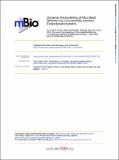Dynamic Remodeling of Microbial Biofilms by Functionally Distinct Exopolysaccharides
Author(s)
Chew, Su Chuen; Kundukad, Binu; Seviour, Thomas; van der Maarel, Johan R. C.; Yang, Liang; Rice, Scott A.; Doyle, Patrick S.; Sjelleberg, Staffan; ... Show more Show less
DownloadChew-2014-Dynamic remodeling o.pdf (4.120Mb)
PUBLISHER_CC
Publisher with Creative Commons License
Creative Commons Attribution
Terms of use
Metadata
Show full item recordAbstract
Biofilms are densely populated communities of microbial cells protected and held together by a matrix of extracellular polymeric substances. The structure and rheological properties of the matrix at the microscale influence the retention and transport of molecules and cells in the biofilm, thereby dictating population and community behavior. Despite its importance, quantitative descriptions of the matrix microstructure and microrheology are limited. Here, particle-tracking microrheology in combination with genetic approaches was used to spatially and temporally study the rheological contributions of the major exopolysaccharides Pel and Psl in Pseudomonas aeruginosa biofilms. Psl increased the elasticity and effective cross-linking within the matrix, which strengthened its scaffold and appeared to facilitate the formation of microcolonies. Conversely, Pel reduced effective cross-linking within the matrix. Without Psl, the matrix becomes more viscous, which facilitates biofilm spreading. The wild-type biofilm decreased in effective cross-linking over time, which would be advantageous for the spreading and colonization of new surfaces. This suggests that there are regulatory mechanisms to control production of the exopolysaccharides that serve to remodel the matrix of developing biofilms. The exopolysaccharides were also found to have profound effects on the spatial organization and integration of P. aeruginosa in a mixed-species biofilm model of P. aeruginosa-Staphylococcus aureus. Pel was required for close association of the two species in mixed-species microcolonies. In contrast, Psl was important for P. aeruginosa to form single-species biofilms on top of S. aureus biofilms. Our results demonstrate that Pel and Psl have distinct physical properties and functional roles during biofilm formation.
Date issued
2014-08Department
Massachusetts Institute of Technology. Department of Chemical EngineeringJournal
mBio
Publisher
American Society for Microbiology
Citation
Chew, S. C., B. Kundukad, T. Seviour, J. R. C. van der Maarel, L. Yang, S. A. Rice, P. Doyle, and S. Kjelleberg. “Dynamic Remodeling of Microbial Biofilms by Functionally Distinct Exopolysaccharides.” mBio 5, no. 4 (July 1, 2014): e01536–14–e01536–14.
Version: Final published version
ISSN
2150-7511
